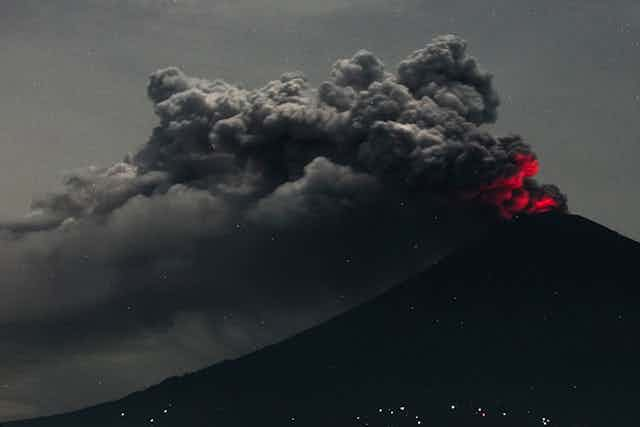The eruption of Mount Agung on the island of Bali in Indonesia has emitted a huge plume of volcanic ash over the region, reaching more than 9km up into the atmosphere. This has disrupted flights over Bali and nearby islands. With the Aviation Colour Code listed as red (the most dangerous), air passengers are once again being stranded, just as many were following the 2010 Eyjafjallajökull eruption in Iceland, or during the Puyehue-Cordón eruption in Chile the following year.
The volcano is still erupting. This means it could become even more explosive – and as such flying nearby remains a risk. In addition, volcanic ash disruption is strongly influenced by wind direction and speed – so the evolving situation still needs to be carefully monitored by the local meteorological offices, and also the Darwin Volcanic Ash Advisory Centre that issues various ash warnings to the aviation sector.
The threat posed by a particular volcano’s ash depends on what it is made of, as no two eruptions are exactly alike. Volcanic ash consists of fragments of pulverised rocks, minerals and volcanic glass (silica) that varies dependent on the chemical composition of the magma.
Once this glass is sucked into jet engines, it is heated up and can accumulate as resolidified ash on the turbines, resulting in engine failure. The higher the concentration and density of glass, the more problematic the ash will be, although even fine ash has electrostatic charge that can lead to electrical failure.

Therefore even at low concentrations, where the ash is barely visible to the naked eye (if at all), it can still pose significant threats and damage to aircraft. Ash also causes significant abrasion to the plane and its windows, while disrupting communications and damaging sensitive equipment.
Mt Agung has previously emitted sulphur-rich gases. Following its most recent major eruption in 1963, its emissions may have led to significant atmospheric cooling of 0.3°C in average northern hemisphere temperatures. High levels of sulphur dioxide and carbon dioxide can also generate discomfort for aircraft passengers, leading to irritations to the eyes, nose, throat and increased airway resistance – as well as corroding the aircraft. Therefore these gas emissions pose a real risk to passenger comfort, as well as cooling of the tropical troposphere.
If ash, no fly
It is no surprise then that a policy of “if ash, no fly” was adopted internationally following two key disasters in Indonesia in 1982 and Alaska in 1989. However, this policy was eventually disregarded during the Eyjafjallajökull ash crisis, after a five-day air-space closure over much of Europe created chaos.

“No fly” was replaced by a safe ash limit of 200-300 micrograms per cubic metre of air, the removal of the flying buffer zone of 60 nautical miles, and then a “time-limited zone” whereby aircraft can fly through higher concentrations of ash for a limited time.
This raised fundamental questions about standardised protocols in volcanic ash hazard management. If they can be ignored or revised based on social and economic circumstances, rather than scientific evidence, what’s the point of them?
Yet the science remains uncertain. It’s hard (and expensive) to work out with any precision where atmospheric ash is located in real time and at what concentration. Equally, the risk it poses to aircraft is not fully understood. Figuring out an official safe threshold of ash concentration would require significant testing on the varying aircraft jet engines, which can cost tens of millions of dollars each.
Years of disruption?
The key question now, is whether Mt Agung will continue to erupt and cause similar types of disruption. The volcano’s previous major eruption lasted between February 1963 and January 1964, with a number of explosive eruptions throughout. If this is anything to go by, the current aviation disruption from volcanic ash may continue for some time.
Indeed, rather than a short, sharp and large emission of ash, some volcanic eruptions can occur on and off for years. Such on-going unpredictability can be far more disruptive, particularly for an island as dependent on tourism as Bali. This of course does not address the ground-based hazards including flows of lava or volcanic debris that put local people in significant danger.
Should Agung continue to erupt, it will be interesting to see whether the ash concentration limits established in 2010 will be implemented. Those affected by the volcanic eruption should have faith in the sophisticated early warning systems set up to monitor the volcanic ash, but if there is one thing we can learn from volcanoes, it is to expect the unexpected.

